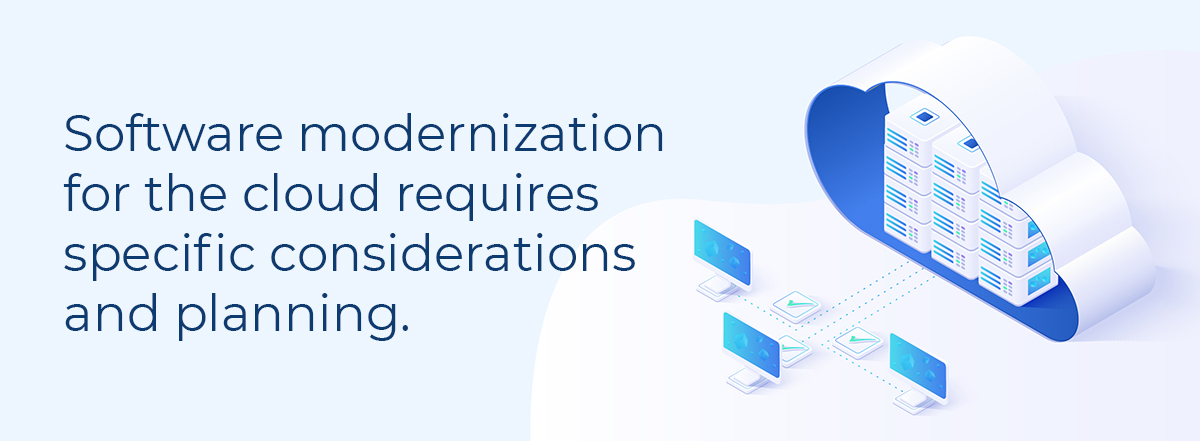Displaying items by tag: risk mitigation
Video: Effectively Leveraging Today's Modernization Solutions for the Cloud

Learn tips to navigate the process in this presentation by TSRI’s VP of Product Development and Service Delivery, Scott Pickett.
Originally aired live on May 18, 2021.
Modernizing for the Future: Effectively Leveraging Today’s Modernization Solutions for the Cloud
Modernization efforts today that target cloud technologies require an understanding of the new environment up-front in the process. With a landscape of constantly evolving technology options, organizations looking to modernize their code, databases and UI, and move to the cloud are confronted with many considerations. The options are daunting, and the path to successful execution is not always clear.
Key Takeaways:
Gain important insights to successfully move beyond language modernization and support best practices for deployment in a cloud environment.
Learn about common benefits, challenges, and pitfalls in cloud migration and modernization.
Dive into the specifics associated with modernizing COBOL programs and the tools, services, and tech stacks required to support them in a modern environment.
---
TSRI is Here for You
As a leading provider of software modernization services, TSRI enables technology readiness for the cloud and other modern architecture environments. We bring software applications into the future quickly, accurately, and efficiently with low risk and minimal business disruption, accomplishing in months what would otherwise take years.
4 Tips for Modernizing with Minimal Business Disruption

Let’s face it. Change is hard. Sometimes, however, change is necessary. When it comes to modernizing mainframe systems that have been in service for decades — especially when considering the possible risks — change requires a lot of forethought.
Disruption to your organization’s business will likely be one of the biggest risk areas in question. These risks can run from prolonged periods that take your business offline to database synchronization between your existing and target applications. So how do organizations move forward with a much-needed modernization to the cloud or a hybrid on-premises solution without causing major disruptions or headaches to their business?
 Here are four tips to help you minimize business disruption risks:
Here are four tips to help you minimize business disruption risks:
1. Understand the scope of your modernization project.
Your organization may want to modernize your applications all at once, but more likely will consider a proof of concept. Great candidates for a proof of concept could be applications most critically in need of modernization, or less-utilized applications to demonstrate how a cloud or on-premises hybrid migration will holistically affect your overall systems portfolio. Understanding the application make-up and baselines of your existing applications will help uncover any additional services that may be required for a successful modernization and determine the target environment these applications will live on and language they use. Setting a realistic scope early on will give insight into which cloud services your applications can leverage, and the benefits associated with those services. Having a good understanding of the scope of the modernization before the work begins will eliminate surprises down the road as well and help prepare for subsequent steps in your organization’s modernization journey.
2. Consider a graceful migration and gradual roll-out.
With the right solution, your organization has the capability to migrate legacy systems one feature, one function, or even one API at a time. Both the existing and modernized applications can then coexist and run concurrently while maintaining or replicating the same data sources. One TSRI client actually operated in this state for over a year as we completed their modernization!
3. Put your services in the target environment under the control of your legacy environment.
Rather than remaking all of the thousands of processes that run to complete specific tasks, organizations can work on the new target environment following a code migration and create a “cloud agent” to enable the legacy mainframe system to run these processes. This temporary fix mitigates risk by eliminating the challenge of isolating problems in real time and allows organizations to move the processes from the legacy application.
4. Take advantage of automation.
Automated modernization processes eliminate the need for humans to rewrite tens (if not hundreds) of thousands of lines of code, which will inevitably introduce errors that need to be isolated and remediated. Manual rewrites can also take years. While human intervention is likely required at various points in an automated modernization, a programmer will need to touch less than .05% of a codebase, meaning issues can be remediated in hours or a few days rather than weeks. Read more about the advantages of automated modernization.
While any modernization will cause some level of disruption, a trusted partner with the experience, tools, and methods in place to migrate legacy systems will minimize risk and make your move to the cloud or a hybrid on-premises architecture as seamless as possible. An experienced, knowledgeable partner will also keep your business requirements top of mind. Remember, automated modernization and refactoring processes will update your code but do not change your business functions. Everything in your applications will perform exactly as they did prior to your modernization—and most likely better— and also enable your organization to leverage the benefits of cloud computing and the up-to-date processes modern systems offer.
---
TSRI is Here for You
As a leading provider of software modernization services, TSRI enables technology readiness for the cloud and other modern architecture environments. We bring software applications into the future quickly, accurately, and efficiently with low risk and minimal business disruption, accomplishing in months what would otherwise take years.
